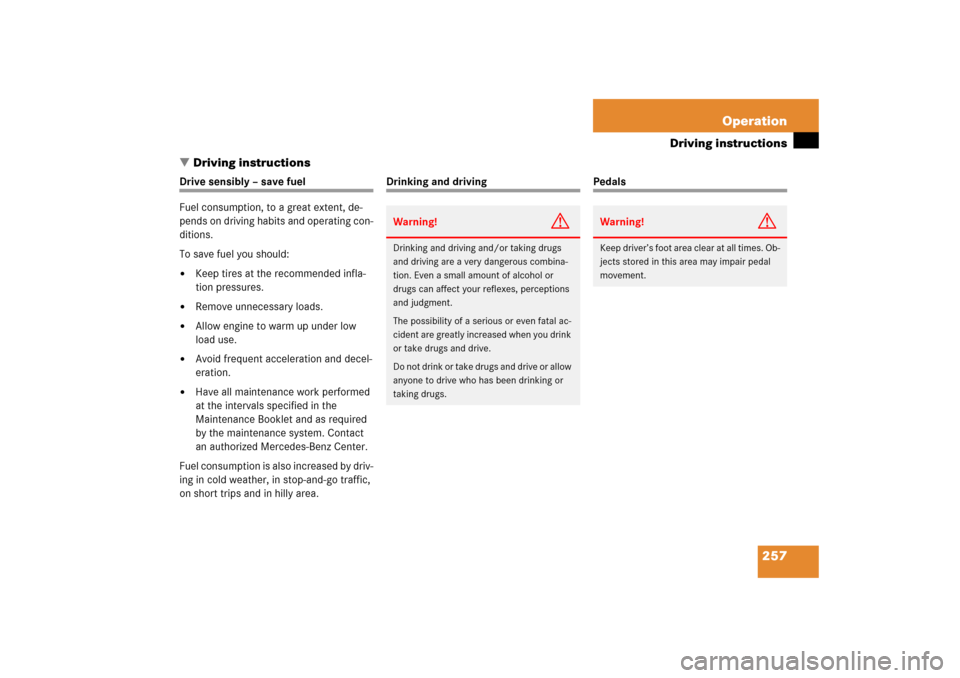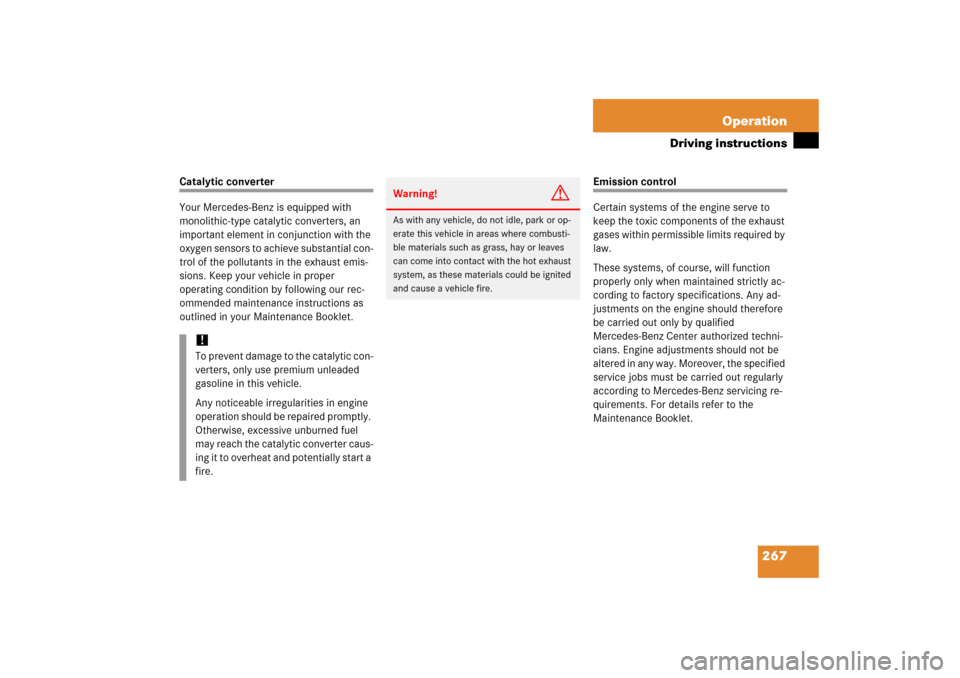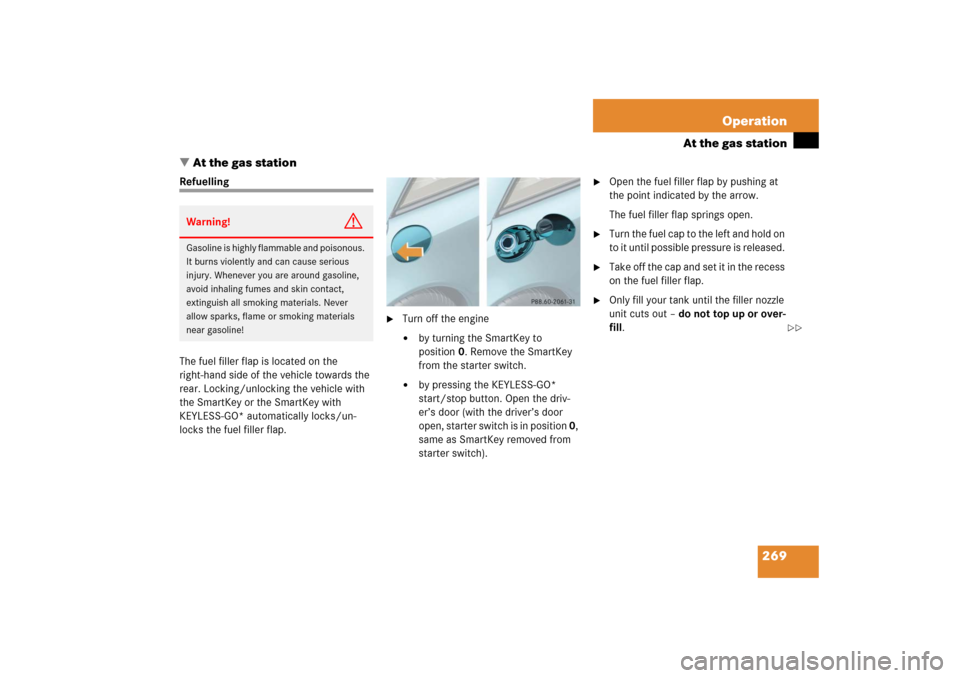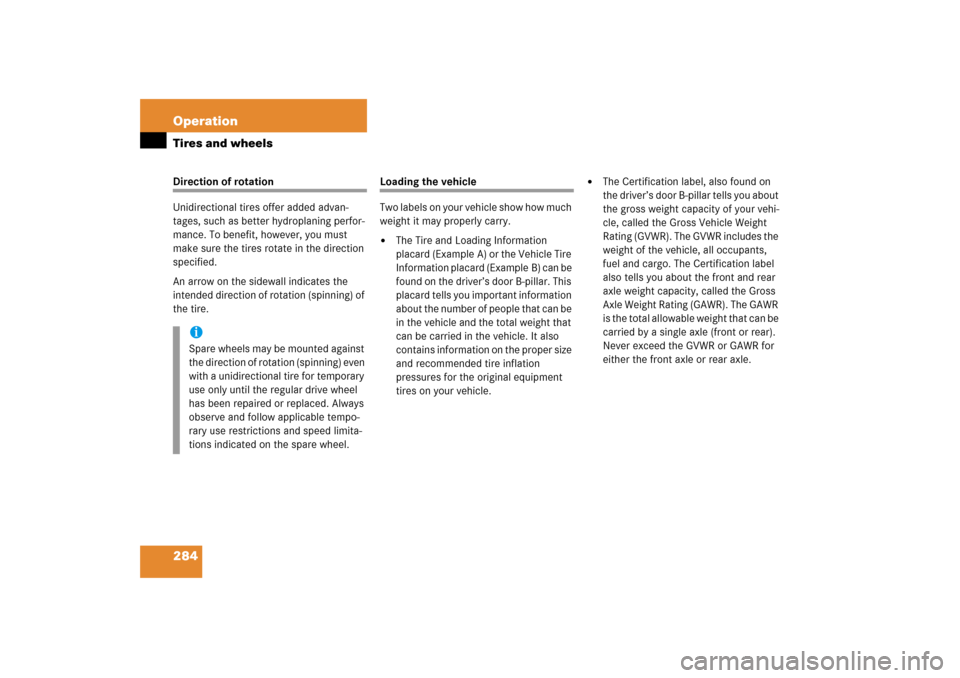Page 221 of 480
220 Controls in detailDriving systemsVehicle level controlYour vehicle automatically adjusts its ride
height to:
�
increase vehicle safety
�
reduce fuel consumption
The vehicle chassis ride height is raised or
lowered according to the selected level
setting and to the vehicle speed:
�
With increasing speed, ride height is re-
duced by up to approximately 1 inch
(25 mm).
�
With decreasing speed, the ride height
is again raised to the selected vehicle
level.Select the level 1 and level 2 settings only
when required by current driving condi-
tions. Otherwise:
�
Fuel consumption may increase.
�
Handling may be impaired.
Warning!
G
To help avoid personal injury, keep hands
and feet away from wheel housing area, and
stay away from under the vehicle when low-
ering the vehicle chassis.
iThese height adjustments are so small
that you may not notice any change.
Page 243 of 480

242 Controls in detailUseful featuresA voice connection between the Roadside
Assistance dispatcher and the occupants
of the vehicle will be established.�
Describe the nature of the need for as-
sistance.
The Mercedes-Benz Roadside Assistance
dispatcher will either dispatch a qualified
Mercedes-Benz technician or arrange to
tow your vehicle to the nearest authorized
Mercedes-Benz Center. For services such
as labor and / or towing, charges may ap-
ply. Refer to the Roadside Assistance
Manual for more information.The following is only available in the USA:
�
Sign and Drive services: Services such
as jump start, a few gallons of fuel or
the replacement of a flat tire with the
vehicle spare tire are obtainable.iThe indicator lamp in the Roadside
Assistance button• remains
illuminated in red for approximately
10 seconds during the system
self-check after switching on the igni-
tion (together with the SOS button and
the Information button¡).
See system self-check (
�page 239) if
the indicator lamp does not come on in
red or stays on longer than approxi-
mately 10 seconds.
If the indicator lamp in the Roadside
Assistance button• is flashing con-
tinuously and there was no voice con-
nection to the Response Center
established, then the Tele Aid system
could not initiate a Roadside Assis-
tance call (e.g. the relevant cellular
phone network is not available). The
message
Call failed
appears in the
multifunction display.
Roadside Assistance calls can be ter-
minated using the tbutton on the
multifunction steering wheel or the re-
spective button for ending a telephone
call on the COMAND headunit.
��
Page 258 of 480

257 Operation
Driving instructions
�Driving instructions
Drive sensibly – save fuel
Fuel consumption, to a great extent, de-
pends on driving habits and operating con-
ditions.
To save fuel you should:�
Keep tires at the recommended infla-
tion pressures.
�
Remove unnecessary loads.
�
Allow engine to warm up under low
load use.
�
Avoid frequent acceleration and decel-
eration.
�
Have all maintenance work performed
at the intervals specified in the
Maintenance Booklet and as required
by the maintenance system. Contact
an authorized Mercedes-Benz Center.
Fuel consumption is also increased by driv-
ing in cold weather, in stop-and-go traffic,
on short trips and in hilly area.
Drinking and driving
Pedals
Warning!
G
Drinking and driving and/or taking drugs
and driving are a very dangerous combina-
tion. Even a small amount of alcohol or
drugs can affect your reflexes, perceptions
and judgment.
The possibility of a serious or even fatal ac-
cident are greatly increased when you drink
or take drugs and drive.
Do not drink or take drugs and drive or allow
anyone to drive who has been drinking or
taking drugs.
Warning!
G
Keep driver’s foot area clear at all times. Ob-
jects stored in this area may impair pedal
movement.
Page 268 of 480

267 Operation
Driving instructions
Catalytic converter
Your Mercedes-Benz is equipped with
monolithic-type catalytic converters, an
important element in conjunction with the
oxygen sensors to achieve substantial con-
trol of the pollutants in the exhaust emis-
sions. Keep your vehicle in proper
operating condition by following our rec-
ommended maintenance instructions as
outlined in your Maintenance Booklet.
Emission control
Certain systems of the engine serve to
keep the toxic components of the exhaust
gases within permissible limits required by
law.
These systems, of course, will function
properly only when maintained strictly ac-
cording to factory specifications. Any ad-
justments on the engine should therefore
be carried out only by qualified
Mercedes-Benz Center authorized techni-
cians. Engine adjustments should not be
altered in any way. Moreover, the specified
service jobs must be carried out regularly
according to Mercedes-Benz servicing re-
quirements. For details refer to the
Maintenance Booklet.
!To prevent damage to the catalytic con-
verters, only use premium unleaded
gasoline in this vehicle.
Any noticeable irregularities in engine
operation should be repaired promptly.
Otherwise, excessive unburned fuel
may reach the catalytic converter caus-
ing it to overheat and potentially start a
fire.
Warning!
G
As with any vehicle, do not idle, park or op-
erate this vehicle in areas where combusti-
ble materials such as grass, hay or leaves
can come into contact with the hot exhaust
system, as these materials could be ignited
and cause a vehicle fire.
Page 270 of 480

269 Operation
At the gas station
�At the gas station
Refuelling
The fuel filler flap is located on the
right-hand side of the vehicle towards the
rear. Locking/unlocking the vehicle with
the SmartKey or the SmartKey with
KEYLESS-GO* automatically locks/un-
locks the fuel filler flap.
�
Turn off the engine�
by turning the SmartKey to
position0. Remove the SmartKey
from the starter switch.
�
by pressing the KEYLESS-GO*
start/stop button. Open the driv-
er’s door (with the driver’s door
open, starter switch is in position 0,
same as SmartKey removed from
starter switch).
�
Open the fuel filler flap by pushing at
the point indicated by the arrow.
The fuel filler flap springs open.
�
Turn the fuel cap to the left and hold on
to it until possible pressure is released.
�
Take off the cap and set it in the recess
on the fuel filler flap.
�
Only fill your tank until the filler nozzle
unit cuts out – do not top up or over-
fill.
Warning!
G
Gasoline is highly flammable and poisonous.
It burns violently and can cause serious
injury. Whenever you are around gasoline,
avoid inhaling fumes and skin contact,
extinguish all smoking materials. Never
allow sparks, flame or smoking materials
near gasoline!
��
Page 271 of 480
270 OperationAt the gas station�
Replace the fuel cap by turning it clock-
wise until it audibly engages.
�
Close the fuel filler flap.
You should hear the latch close shut.Warning!
G
Overfilling of the fuel tank may create pres-
sure in the system which could cause a gas
discharge. This could cause the gas to spray
back out when removing the fuel pump noz-
zle, which could cause personal injury.
iOnly use premium unleaded gasoline
with a minimum Posted Octane Rating
of 91 (average of 96 RON / 86 MON).
Information on gasoline quality can
normally be found on the fuel pump.
For more information on gasoline, see
“Premium unleaded gasoline”
(�page 448) or the Factory Approved
Service Pamphlet.
iLeaving the engine running and the fuel
cap open can cause the engine mal-
function indicator lamp ú (USA
only) or the engine malfunction indica-
tor lamp ± (Canada only) to illumi-
nate.
For more information, see the “Practi-
cal hints” section (
�page 335).
��
Page 272 of 480

271 Operation
At the gas station
Check regularly and before a long trip
For information on quantities and require-
ments of operating agents, see “Fuels,
coolants, lubricants, etc.” (
�page 445).
�
Open the hood (
�page 272).
1Windshield washer and headlamp
cleaning system
2Brake fluid
3Coolant levelWindshield washer and headlamp
cleaning system
For information on refilling the reservoir,
see “Windshield washer system and
headlamp cleaning system” (
�page 280).
Brake fluid
For information on brake fluid, see “Fuels,
coolants, lubricants, etc.” (
�page 445).Coolant level
For information on checking the coolant
level, see “Coolant” (
�page 278).
Engine oil level
For more information on checking the en-
gine oil level, see “Checking engine oil lev-
el with the control system” (
�page 274).
Vehicle lighting
Check function and cleanliness. For more
information, see “Replacing bulbs”
(
�page 391).
Exterior lamp switch, see “Switching on
headlamps” (
�page 53).
Tire inflation pressure
For information on checking the tire infla-
tion pressure, see “Checking tire inflation
pressure” (
�page 293).
!If you find that the brake fluid in the
brake fluid reservoir has fallen to the
minimum mark or below, have the
brake system checked for brake pad
thickness and leaks immediately. Noti-
fy an authorized Mercedes-Benz Center
immediately. Do not add brake fluid as
this will not solve the problem. For
more information, see the “Practical
hints” section (
�page 363).
Page 285 of 480

284 OperationTires and wheelsDirection of rotation
Unidirectional tires offer added advan-
tages, such as better hydroplaning perfor-
mance. To benefit, however, you must
make sure the tires rotate in the direction
specified.
An arrow on the sidewall indicates the
intended direction of rotation (spinning) of
the tire.
Loading the vehicle
Two labels on your vehicle show how much
weight it may properly carry. �
The Tire and Loading Information
placard (Example A) or the Vehicle Tire
Information placard (Example B) can be
found on the driver’s door B-pillar. This
placard tells you important information
about the number of people that can be
in the vehicle and the total weight that
can be carried in the vehicle. It also
contains information on the proper size
and recommended tire inflation
pressures for the original equipment
tires on your vehicle.
�
The Certification label, also found on
the driver’s door B-pillar tells you about
the gross weight capacity of your vehi-
cle, called the Gross Vehicle Weight
Rating (GVWR). The GVWR includes the
weight of the vehicle, all occupants,
fuel and cargo. The Certification label
also tells you about the front and rear
axle weight capacity, called the Gross
Axle Weight Rating (GAWR). The GAWR
is the total allowable weight that can be
carried by a single axle (front or rear).
Never exceed the GVWR or GAWR for
either the front axle or rear axle.
iSpare wheels may be mounted against
the direction of rotation (spinning) even
with a unidirectional tire for temporary
use only until the regular drive wheel
has been repaired or replaced. Always
observe and follow applicable tempo-
rary use restrictions and speed limita-
tions indicated on the spare wheel.